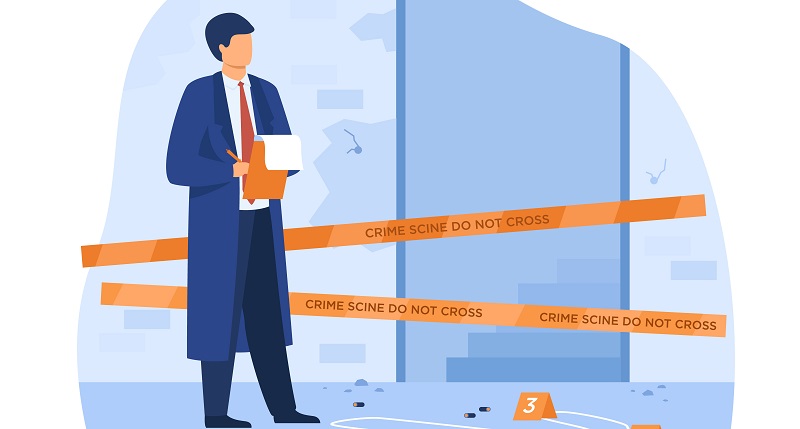One of the most important uses of Artificial Intelligence (AI) and Machine Learning (ML) lies in the detection and prevention of criminal activities. Today, companies are widely using AI-powered computer vision devices to predict and detect crimes ranging from frauds and theft to violence and cybercrimes.
The developments in computer vision technologies enabled authorities to simplify incident reporting and crime detection more efficiently. A study done by Gartner says the global computer vision market was estimated at $10.6 billion in 2019 and is estimated to grow at a compound annual growth rate of 7.6% from 2020 to 2027.
Though incident reporting and crime detection covers only a part of this estimated mareket size comparing with all the use cases of computer vision, as a global solution for common good, these two use cases holds more importance than it looks.
In today’s world where criminals seem to evolve in tandem with the development of technology, experts believe that only AI can help keep up with advanced crime detection. Highly advanced algorithms, along with Machine Learning and predictive analytics solutions have helped in enhancing the accuracy in monitoring and reporting crimes today. And further advancement is underway to find out newer ways of employing AI for better management of crimes and prevent them altogether.
Computer Vision helps in real-time crime reporting
Security solutions provided by AI-enabled Computer Vision include a wide range of possibilities for detecting objects and identifying unusual patterns in individual or mass behavior indicative of crime or violence. It employs several object detection algorithms for spotting stolen or abandoned objects, weapons as well as threats; and activity recognizing algorithms help to sense violence, thefts, and falls.
Computer Vision comes equipped with advanced intelligent video analytics capabilities which accurately identify and report violence or crime. With its high degree of reliability and speed, it can potentially save lives by extracting appropriate information from video footage, and accurately processing it for human understanding. And all of this happens in real-time. Computer Vision is fully compliant with General Data Protection Regulation (GDPR) and does not involve facial recognition or person identification technologies to any extent. Moreover, this application is also designed to not collect or save personal data in any form.
Organizations using Computer Vision can develop a prototype that can analyze videos deeper and further contribute to efficient violence detection and crime reporting. As soon as it senses violence or fights in video footage, the algorithms working in the backend shoot an alert to the security personnel or police, who can then assess the whole situation and choose an appropriate action plan. So, in other words, this software can be used to act like a public safety officer driven by artificial intelligence.
Let us find out how AI-driven Computer Vision can be used for violence detection and reporting.
Scenario A – Crime reporting in real-time using automatic violence and fight detection technology
Automated violence and fight detection technology helps ensure public safety in monitored areas.
With AI-powered violence and fight detection technologies, companies can automatically monitor video footage from security cameras in real-time and report the same to the Law Enforcing Agencies. This is especially helpful in the prevention of violence since security agencies can get enough time to chart out the required plan of action to proactively stop fights. Moreover, the data collected by this application can be used to create reports related to security levels in a specific area and prevent further crimes based on AI insights
Scenario B – Exposing police misconduct using automatic violence and fight detection technology
In the light of the Black Lives Matter movement, authorities can now spot incidents of police brutality using real-time video footage. Real-time authentic video clippings are essential for proving police misconduct and bringing about a fundamental change. Automatic violence detection technology has simplified and accelerated the cumbersome work of human rights groups and advocacy teams. Now, they no longer need to scrutinize hours and hours of video footage. The technology automatically selects relevant clippings that bear evidence of violence which can help in legal proceedings.
The use of this AI-driven technology, therefore, ensures the safety of communities. It helps accelerate reformation in case of misconduct by police or other security agencies.
Ensuring crowd safety using automatic camera-based fall detection technology
AI-driven fall detection technology integrated with intelligent video analytics software is another efficient camera-based security solution. This is especially helpful in large public gatherings that bring major security challenges like crowd crushes. Automated fall detection can help in the prevention of stampedes by sending alarms to security teams and event organizers about potential crowd crushes before they assume serious proportions.
Automatic fall detection technology is easily implementable in all kinds of mass meetings to control the crowd and enforce safety of the public. This use case is more suitable to implement in situation like our current time. Through accurate video analysis authorities can identify whether people are observing distancing and obeying the laws in closed or monitored areas.
Bottom Line
The use cases of computer vision technologies are not limited to incident reporting and crime detection services, but, can be leveraged across many scenarios in and around our society. Being a pioneer in solving critical problem with advanced technologies like AI, ML and Computer vision, ZiniosEdge is always there to help to create solutions using computer vision technologies. Please reach us anytime to create you computer vision solutions.

